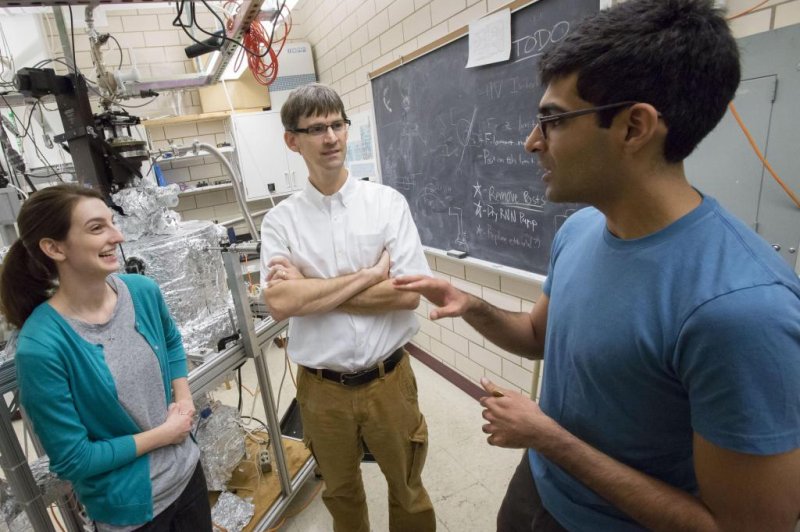With the help of graduate students Mindy Rak, left, and Anshul Kogar, right, physics professor Peter Abbamonte, at center, has proven the existence of a new form of matter called excitonium. Photo by L. Brian Stauffer/University of Illinois at Urbana-Champaign
Dec. 11 (UPI) -- The existence of excitonium was theorized nearly a half-century ago. But scientists at the University of Illinois at Urbana-Champaign have for the first time proven its existence -- a new form of matter.
Scientists confirmed the existence of excitonium after analyzing crystals belonging to the transition metal dichalcogenide titanium diselenide, or 1T-TiSe2. The new form of matter is a condensate made up of excitons, particles featuring an escaped electron and the gap left behind by its absence.
The odd quantum mechanical pairing among the excitons lends excitonium unique macroscopic quantum properties, similar to the properties of a superconductor or insulating electronic crystal.
Semiconductors feature bands of energy called valence bands. The bands are full of electrons. When electrons on the edge of the valence bands get excited they can jump the energy gap to the neighboring conduction band, a band without electrons. The escaped electron leaves behind a hole.
The hole left behind by the electron takes on a positive charge and attracts the newly escaped electron. Together, the pair form a composite particle, or boson, called an exciton.
Though predicted in theory nearly 50 years ago, scientists have failed until now to directly observe excitonium. Finding the new form of matter was complicated by the fact that its quantum properties appear similar to the Peierls phase, an oscillation of atomic positions measured in a one-dimensional crystal.
Scientists were able to differentiate between the two signatures using a new analysis technique called momentum-resolved electron energy-loss spectroscopy, or M-EELS. The method is especially sensitive to band excitations, allowing the researchers to measure the excitations of low-energy bosonic particles.
Their observations revealed direct observations of a soft plasmon phase in the transition metal, the precursor to exciton condensation and smoking gun scientists needed to confirm the matter's existence.
"This result is of cosmic significance," Peter Abbamonte, physics professor at the University of Illinois, said in a news release. "Ever since the term 'excitonium' was coined in the 1960s by Harvard theoretical physicist Bert Halperin, physicists have sought to demonstrate its existence."
Scientists published their breakthrough discovery in the journal Science.
Researchers believe their new analysis technique could be used to study a variety of other mysterious quantum mechanical signals and theoretical phases.















